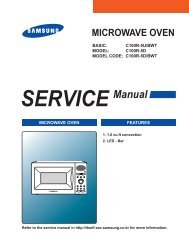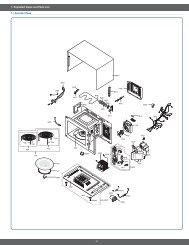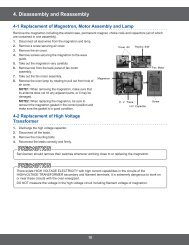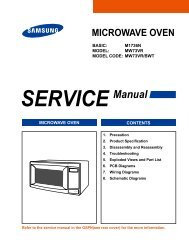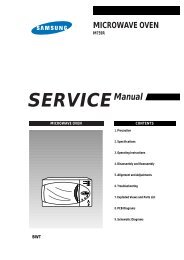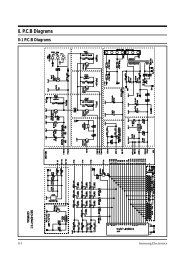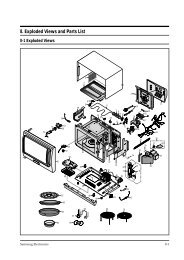SAMSUNG CE959GT.pdf
SAMSUNG CE959GT.pdf
SAMSUNG CE959GT.pdf
Create successful ePaper yourself
Turn your PDF publications into a flip-book with our unique Google optimized e-Paper software.
1. Precaution<br />
Follow these special safety precautions. Although the microwave oven is completely safe during ordinary<br />
use, repair work can be extremely hazardous due to possible exposure to microwave radiation, as well as<br />
potentially lethal high voltages and currents.<br />
1-1 Safety precautions ( )<br />
1. All repairs should be done in accordance<br />
with the procedures described in this<br />
manual. This product complies with<br />
Federal Performance Standard 21 CFR<br />
Subchapter J (DHHS).<br />
2. Microwave emission check should be<br />
performed to prior to servicing if the oven is<br />
operative.<br />
3. If the oven operates with the door open :<br />
Instruct the user not to operate the oven and<br />
contact the manufacturer and the center for<br />
devices and radiological health immediatly.<br />
4. Notify the Central Service Center if the<br />
microwave leakage exceeds 5 mW/cm 2<br />
5. Check all grounds.<br />
6. Do not power the MWO from a "2-prong"<br />
AC cord. Be sure that all of the built-in<br />
protective devices are replaced. Restore any<br />
missing protective shields.<br />
7. When reinstalling the chassis and its<br />
assemblies, be sure to restore all protective<br />
devices, including: nonmetallic control<br />
knobs and compartment covers.<br />
8. Make sure that there are no cabinet openings<br />
through which people--particularly<br />
children--might insert objects and contact<br />
dangerous voltages. Examples: Lamp hole,<br />
ventilation slots.<br />
9. Inform the manufacturer of any oven found<br />
to have emmission in excess of 5 mW/cm 2,<br />
Make repairs to bring the unit into<br />
compliance at no cost to owner and try to<br />
determine cause.<br />
Instruct owner not to use oven until it has<br />
been brought into compliance.<br />
CENTRAL SERVICE CENTER<br />
10. Service technicians should remove their<br />
watches while repairing an MWO.<br />
11. To avoid any possible radiation hazard,<br />
replace parts in accordance with the wiring<br />
diagram. Also, use only the exact<br />
replacements for the following parts:<br />
Primary and secondary interlock switches,<br />
interlock monitor switch.<br />
12. If the fuse is blown by the Interlock Monitor<br />
Switch: Replace all of the following at the<br />
same time: Primary and secondary switches,<br />
as well as the Interlock Monitor Switch. The<br />
correct adjustment of these switches is<br />
described elsewhere in this manual. Make<br />
sure that the fuse has the correct rating for<br />
the particular model being repaired.<br />
13. Design Alteration Warning:<br />
Use exact replacement parts only, i.e., only<br />
those that are specified in the drawings<br />
and parts lists of this manual. This is<br />
especially important for the Interlock<br />
switches, described above. Never alter or<br />
add to the mechanical or electrical design<br />
of the MWO. Any design changes or<br />
additions will void the manufacturer's<br />
warranty.10.Always unplug the unit's AC<br />
power cord from the AC power source<br />
before attempting to remove or reinstall<br />
any component or assembly.<br />
14. Never defeat any of the B+ voltage<br />
interlocks. Do not apply AC power to the<br />
unit (or any of its assemblies) unless all<br />
solid-state heat sinks are correctly installed.<br />
15. Some semiconductor ("solid state") devices<br />
are easily damaged by static electricity. Such<br />
components are called Electrostatically<br />
Sensitive Devices (ESDs). Examples include<br />
integrated circuits and field-effect<br />
transistors.<br />
Immediately before handling any<br />
semiconductor components or assemblies,<br />
drain the electrostatic charge from your<br />
body by touching a known earth ground.<br />
16. Always connect a test instrument's ground<br />
lead to the instrument chassis ground before<br />
connecting the positive lead; always remove<br />
the instrument's ground lead last.<br />
Samsung Electronics 1-1



